|
- Catalog (in stock)
- Back-Catalog
- Mail Order
- Online Order
- Sounds
- Instruments
- Projects
- History Face
- ten years 87-97
- Review Face
- our friends
- Albis Face
- Albis - Photos
- Albis Work
- Links
- Home
- Contact
- Profil YouTube
- Overton Network
P & C December 1998
- Face Music / Albi
- last update 03-2016
|
- Songs of Armenia
The text and the meaning of the songs determine their theme or genre. The Armenian folk songs are classified in the following genres:
|
- Work songs, including women's work songs and "horovel", that is plowing songs or songs of the field. |
|
All work songs describe something of the working process and are sung to accompany work. Songs of the fields are called "horovel". This is a large, many-sided genre, in which the peasant expresses his thoughts, desires and his love for the nature, all combined with a deep respect for his work. (Horovel is also called “gutani yerg,” or, song of the plough. The horovel and gutani yerg are one and the same). Singing helps him, not only during the period of work, but to endure and overcome the trials and difficulties of life.
|
|
- Ceremonial songs (i.e. for weddings, funerals, etc.) |
|
Ceremonial songs are sung at weddings, at funerals (songs of sadness and mourning) and on the occasion of various other holidays and at festive celebrations. Every ceremony or holiday has its particular ceremonial song. The roots of this genre are to be found in pagan times, but with the beginning of the Christian era, they have assumed new meaning and importance, which they have maintained till today.
|
|
- Epic songs - In Armenian music tradition, epic songs are thematically distinguished into two categories. |
|
- 1. The one with the bigger repertory contains mythological themes of pagan Armenia like "Haik and Bel", "Dork Angegh", "Ara and Shamiram"; those are classified as "fables".
|
|
- 2. The others are the so-called heroic songs telling about the history and the traditions of these people and their heroes, such as e.g. "Sasuntzi Davith" dealing with the adventures of the hero of epics, David of Sasun, in his defense against infidel Arab invaders from Egypt and Persia (today Iran).
|
|
The epic was based on oral tradition that presumably dates from the 8th to 10th century; it was widely known from the 16th to the 19th century and was finally written down in 1873.
|
|
- Historical songs - These songs reflect Armenian history and reality. Through such songs, we can learn about the real events of Armenian history in various times.
|
|
- Dance songs (songs sung during a dance). Dance songs are often combined with some kind of game. The songs are usually short, and they are sung during group dancing. The names of some of these songs are "Khagh, Yaili, Gyond, Taghaloo and Mani". The roots of these songs are hidden in the pagan era, emerging again at the same time as the ceremonial songs. The main theme of this genre is love for the nature and for life, or for a person. Dance songs can be distinguished by their repetitive movements that reflect a short series of steps, which are repeated many times. Dance songs are always happy songs.
|
|
- Humorous songs - Humorous songs provide a unique method for people to understand and judge man's everyday weaknesses (jealousy, greed, etc.) as well as to offer acceptable moral limits to them. In this type of music, the meaning is similar to that of the dance song, where the rhythm, or the tempo, plays an important role. The songs reveal in this way their content or meaning.
|
|
- Lullabies - Lullabies belong to the oldest musical genre created by man. Well-known Armenian lullabies are "Nana, Loorig, Roorig, Ayer, Hayroor" and others. The main theme of a lullaby is the love for the child. Various subjects or feelings are expressed in lullabies, when the mother is rocking the cradle and singing, forgetting her daily burden, remembering past loves, embracing touching memories. Doing so, she is also passing past lamentations on to the next generation, thus awakening in the young heart a heroic soul and the feeling for the homeland.
|
|
- Lyric songs, love songs - Lyric songs make up the largest part of the Armenian traditional song repertory. The themes are manifold, including love, social uncertainties and upheavals, tragedies suffered under foreign rule, and various deep expressions of the soul and life.
|
|
- Songs of the emigrants (these songs tell stories about tragedy, persecution, emigration, torture and grief of the Armenian people). In Armenian popular culture, the emigrant's song is also called "Anduni", meaning one who, without choice, must leave his home. These songs tell the story of emigrants, who were forced to leave the country and search for good fortune and happiness, but their hearts are burning from a deep longing and grief and the spiritual and psychological pressures of their life. Classic examples of this genre are "Kroonk" (The crane) and "Anduni" (Homeless).
|
In the village, every single villager can sing, as everybody is present at the birth or creation of a song or the lyrics of a song. But nobody, however, knows who has created this particular playful song or dance.
- Old Armenian Notation
Since ancient times, the Armenian nation has had its own system of notation, which is called "the system of the Armenian khaz." It is a type of neumatic notation. The khaz system made it possible to put down monovocal melodies and sharakans, as they indicated the voice pitch, its duration, the strength of the voice, hue, the ornamentation of the melodic line, and other elements.
Khaz notation was used from the 8th up to the 18th centuries - in the beginning, only for religious songs, later on also for folk music. However, as it contained a great amount of different symbols and conventional signs, khaz notation was difficult to use on a practical basis, in respect of putting down the melody and reading it. This is why it was gradually put out of use, and in the 18th-19th centuries it was completely forgotten. Starting at the beginning of the first quarter of the 19th century, a new, simpler and easier-to-use system was introduced in Armenian music.
The new system was compiled and developed by the musician and reformer of the Armenian notation, teacher Hampartsoom Limonjian (1768-1839). After thorough and careful study of Armenian spiritual music throughout many years, he created the {Armenian new notation} in the years 1813-15. The reasons for creating this new system are the following:
|
1) To make the notation system easier to learn and use |
|
2) To compile a system which would use some elements of the old khaz notation. |
As the new system is also neumatic and as it is not applied to the European 5-line bar system, it gives the chance to write the melody in the space between the lines of the text of the {spiritual} poems, thus facilitating the vocal performance of the texts. On his journeys of studies and recording of folk music, Komitas mostly used this notation system.
There are many text books teaching this notation system, the most famous of which are those by Nikoghayos Tashjian {Vagharshapat, 1874}, Arshak Broutian {Vagharshapat, 1890}, and Robert Atayan {Yerevan, 1950}. This notation has been used till our days, and it is being taught at the Yerevan State Conservatory, Gevorgian Seminary, and other musical establishments. Thousands of sharakans, chants, melodies and the Armenian Mass have reached us in the form of this notation.
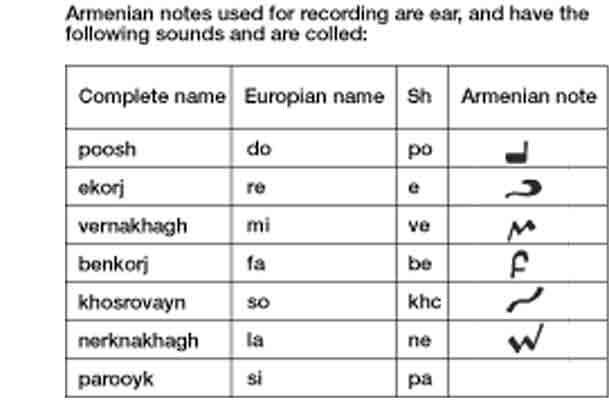
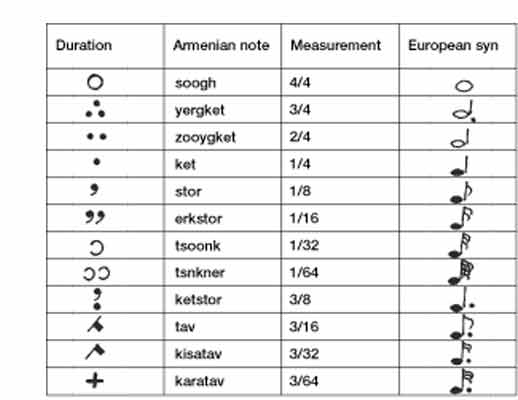
Example: This is the example of a "religious" song.


- Instruments of Armenia
Many of this instruments are played in the Arab countries, in Georgia, the Iran, and Turkey.
- Duduk - dham duduk (wind instrument)
Armenian oboe. A single or double reed wind instrument made of apricot wood with a sound that has a human-like voice quality. It has a cylindrical wooden pipe, a broad reed and nine holes (8 finger-holes and one thumb-hole). It has a warm, soft, slightly nasal timbre and full tone. This instrument is equally used for slow lyrical tunes (accompanying folk songs) and faster dance-tunes, and it is also played solo. The tuning is basically untempered diatonic, though chromatic notes can be obtained by partially opening or closing the finger holes. The double reed is a slit-tube-like reed. The origin of the duduk goes back to times before Christ.
|

|
- Kaval (wind instrument)
It is a wooden end-blown open or a rim-blown flute similar to the nay of the Arab world. It is generally made of boxwood with eight finger-holes producing a diatonic scale (can also be made in cane, bone or brass). It has thickenings at the ends, and its tone is very misty. The instrument is primarily a pastoral instrument. It is a shepherd's instrument used to accompany dancing (sometimes with other instruments),
|
- Schawn - folk clarinet or hornpipe (wind-instrument)
|
| It has a single reed which may be covered by a mouthpiece (or "wind-cap"). There is a wooden barrel with finger-holes and a flared bell. It can be made of various natural or man-made materials; cow horn bells are common, but all-wood. The instrument has a diatonic tuning which comes in various keys (G, A, F) and in soprano (i.e. "normal), alto, and even piccolo forms. They can be tuned by adjusting the reeds. The instrument is normally tuned in the key of G (you get all naturals, no accidentals), and you only get one octave's worth of notes. You can also get the final non-diminished 7th tone with alternate fingering. |

|
- Shvi - tav shvi (wind instrument)
A wind instrument, an end-blown duct flute with a libium mouth piece, similar to that of a recorder. It may be made of reed, wood or bamboo. It has a range of an octave and a half. The pitches vary with the size of the instrument. Its average length is 32 cm, with seven finger-holes and one thumb-hole. At the upper end, near the mouthpiece, there is a metal (usually tin) ring for adjusting the sound. This can be made in various sizes. It is played solo and in ensembles of folk instruments, and it is used for everyday music-making and by shepherds, who sometimes use it in place of the more difficult pastoral "blul".
|
 tav shvi tav shvi
  shvi shvi
 blul blul
|
|
|
- Sring (wind instrument)
Shepherd's flute of medieval Armenia. "Sring" is also the common term for end-blown flutes in general. These flutes are made either of storke bone or bamboo (with the pitch of a piccolo) or wood from the apricot tree or cane, and they have seven or eight finger-holes, producing a diatonic scale. Shepherds play on the sring various signals and tunes connected with their work, as well as the tunes of lyrical love songs called chaban byaty or programme pieces. The sring is also played together with the dap and the dhol for dance music. Specimens of sring have been found at Garni and Dvin (Armenia) and have been dated back to the period between the 5th century BC and the Middle Ages. These flutes are analogous to the contemporary blul. The Armenian musicologist Komitas thought that the sring is the most characteristic among the Armenian national instruments. It originates from Eastern Armenia (Caucasus region).
|
- Sulich - Ocarina (wind instrument)
This is a ceramic whistle resembling the ocarina and shaped like a sweet potato; it has nine finger-holes.
|
- Zurna (wind instrument)
Folk oboe of the Arab world, Turkey, southeast Europe and parts of Asia. It takes many forms but is most commonly a conical wooden tube with a double reed and usually a piroutte. It is also found as "zurna" in the Caucasus (Armenia, Daghestan, Azerbaijan and to a lesser extent in Georgia).
In Armenia, the structure is identical; a thin brass tube, a kind of grip which is placed inside a piece of notched wood, itself within the body of the instrument. There is a U-shaped staple, designed to keep the first holes open; it can, however, by means of slight rotation, act as a capo tasto and close them. A part of the staple of whole reed is held in the musician's mouth, and his teeth press on the brass tube. The pirouette is a small disc of metal, wood, ivory, mother-of-pearl or other material, which lies against the player's lips and facilitates breath control. The body of the instrument is made of a single conical piece of wood, widening towards the end, which is bell-shaped or flared and 6 to 12 cm in diameter. Many different kinds of wood, however, are known to have been used. In earlier times, apricot has become the most common. The body has seven finger-holes and a thumb-hole. The compass of the zurna is about one and a half octaves, depending on the model; the upper register tends to be shrill. The player rarely uses the instrument's full compass. Some instruments have a stable drone, and some a shifting one. They convey the impression of playing diatonically, picking out the notes of the scale distinctly. Players use circular breathing. The zurna is used for weddings, dances, celebrations and many other situations.
|
 
|
- Tulum - bagpipe (wind instrument)
The tulum is the main instrument of north-eastern Anatolia.
The bag is made of goat- or sheepskin, and the double chanter is inserted in a wooden stock. Two or three of the upper holes in one of the pipes are sometimes sealed with beeswax, and the chanter often has a cow-horn bell. There is no separate drone pipe. It is used to accompany songs and dances.
|
- Kanun (string instrument)
The kanun is a plucked box zither of the Middle East, North Africa and parts of Asia. It is trapeziform in shape, with one of the sides being rectangular. Armenian models never have more than two string-levers. In order to play the instrument, the musicians place it either on their knees or on a table. The strings are plucked by means of a ring-shaped plectrum put on the index fingers. The range of the kanun varies between three and four octaves. In Armenia it is played as a solo instrument or in ensembles. The instrument has 24 triple courses of gut strings tuned to a diatonic scale of D major.
|
- Santur (string instrument)
Box zither of the Middle East, the Caucasus, southeastern Europe and South Asia. The santur consists of a trapeziform case made of walnut wood (or rosewood, betel palm). The strings are fixed to hitch-pins along the left-hand side and wound round metal west-pins on the right by means of which they are tuned with a tuning-key. Each quadruple set of strings rests on a movable bridge of hardwood. These are aligned almost in parallel with the sides of the case. The right-hand rank corresponds to the bass strings and that on the left to the treble strings. In the centre of the santur the low-pitched strings on the right cross the high-pitched strings on the left. The santur is played by striking the strings with two hammers held in three fingers of each hand.
In the Caucasus and the Near East, the santur may have from 13 to 26 courses from triple to quintuple, and it is mainly used by folk poet singers and ensembles.
|

|
- Oud - Ud (string instrument)
The oud is a short-necked plucked lute, like the European lute. The body has evolved considerablly from the original pear shape and is made from light-weight wood. It consists of a strongly rounded back and a flat front surface. The soundboard is pierced by one quite large soundhole. The holes are plain or richly ornamented. The bridge bears the strings and stands about 10 cm from the lower edge of the soundbox, a piece of fish-skin or leather, or occasionally of shell. It consists of a series of ribs. They are plucked with a plectrum made of an eagle's feather and held between thumb and index finger. A shell or plastic plectrum may be used today. There are five pairs of strings and one bass string. The strings of the contemporary oud are twisted, or spirally reinforced. This oud is played by Armenians from Western Armenia and the Middle East.
|
|
- Saz (string instrument)
The term "saz" is now used to designate a long-necked fretted lute of the tanbur family. In the Iran and the Caucasus the saz is possibly a descendant of the jugti-saz (double-saz), a three-stringed lute. Its pear-shaped resonator is carved from a single piece of wood, or it is fitted together from wooden staves. It has a thin wooden soundboard with small soundholes. It is played with a plectrum. The Caucasian saz is primarily the instrument of the ashug (folk poet-musicians); its traditional repertory contains heroic historical songs, epics, romantic stories and humorous, satirical and love songs. The Armenian saz differs little in function and performance, it is from 55 to 110 cm long, with metal strings arranged in three or four double or triple courses. The first course is used for the melody, the middle course or courses for a sustained drone, and the last performs a supplementary role, harmonic and partly melodic.
|
 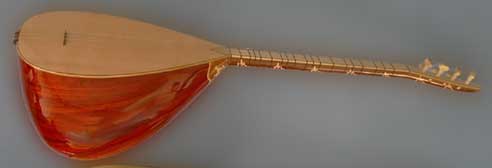
|
- Tar (string instrument)
Plucked lute of the "rabab" family, with a membrane as a soundtable. It is used in popular urban entertainments. The Caucasian tar differs from the Iranian one by its shallower, less curved body. It has a wider neck and usually 22 gut frets. These can be adjusted to produce microtonal intervals for traditional mugarn performance or to the 12-note tempered scale. The membrane is made of fish-skin, bladder or the pericardium of a bullock. The strings are plucked with a bone plectrum. The timbre is harder and drier, and its playing style is closer to that of the rabab. It is held almost horizontally against the upper chest, and the performer shakes the tar slightly to produce a vibrating sound. The same effect is also achieved by rapidly moving the little finger of the right hand. The Caucasian tar is highly esteemed in Azerbaijan and Armenia; it is also found in Uzbek ensembles.
|
|
|
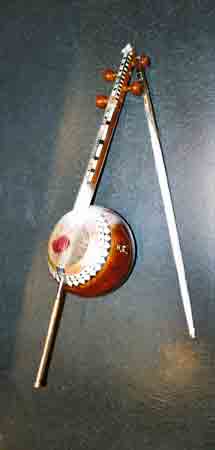
|
- Kamanche (string instrument)
(Persian: "little bow"). This is a spike fiddle of the Iran and the Caucasus - Armenia, Azerbaijan and Georgia "kemanche" - also known in Turkey and Egypt as the "rabab", in Iraq as the "joze" and in northern Afghanistan and parts of Central Asia as "ghichak".The classical Caucasian and Iranian "kamanche" has a spherical body built of tapering wooden sections or carved in one piece. It is often decorated with mother-of-pearl and bone. The bridge rests on a circular sound-table, which is made of animal membrane, bladder or fish-skin. The rounded neck is fixed to a spike which passes through the body and acts as a support for the instrument. It formerly had three silk strings, and these were tuned in 4ths. During his performance the player rests the instrument vertically on his knee, and he turns the instrument to meet the bow rather than guiding the bow accross the strings. The bow hair is tightened by inserting the fingers between the horsehair and the wood.

|
|
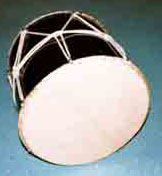
 |
- Dhol (larger) - Davul (smaller) – (percussion instrument)
Double-headed cylindrical drum. One membrane is thick and produces a deep sound, while the other one is thinner, generating a higher pitch. The membranes are made of sheepskin or goatskin, which are tensioned to each other by a variety of zigzag lacing around the cylinder. It is either played with two wooden sticks (one usually thicker than the other) on both membranes, or with the fingers and palms on one membrane. A variety of dances and songs are accompanied by the dhol. Many rhythmic patterns are used, giving the music an improvisatory character and its beat. In medieval times, the dhol was also known as the gos.
|
|
  |
- Dap - frame drum (percussion instrument)
The dap is a single-headed Armeniam frame drum, equivalent of the Arab duff.
By striking the centre of the edge of the membrane, sounds of differing pitch and timbre can be produced.
The wooden framedrum is 35 to 50 cm in diamenter, with jingles (metal rings, rattles, silver coins etc) attached inside the frame and sound when the drum is played or shaken.
|
|

|
- Dumbeg - Darabuka (percussion instrument)
This is an hour-glass shaped drum with lamb skin at one side, where the skin head is directly attached by nails or glue, and an open end at the other side. The body of the dumbeg is constructed of either metal or clay. The Darabuka is made from pottery, wood or metal. It is played with hands and fingers while being held on the lap or between the knees.
|
|
|
We would like to thank all of our Armenian and Swiss friends for their help with the photos, translation and review:
Andranik Michaelian, Albi and Hermelinde Steiner.
|
PageTop

|
